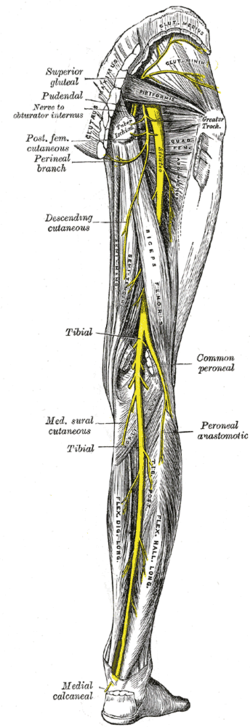Posterior cutaneous nerve of thigh
| Posterior cutaneous nerve of thigh | |
|---|---|
 Cross-section through the middle of the thigh. (Posterior femoral cutaneous nerve labeled at bottom.) | |
 Nerves of the right lower extremity. Posterior view. (Post. fem. cutaneus labeled at upper left.) | |
| Details | |
| From | sacral plexus (S1,S2,S3) |
| To | inferior clunial nerves, perineal branches |
| Identifiers | |
| Latin | nervus cutaneus femoris posterior |
| TA98 | A14.2.07.033 |
| TA2 | 6566 |
| FMA | 45337 |
| Anatomical terms of neuroanatomy | |
This article includes a list of references, related reading, or external links, but its sources remain unclear because it lacks inline citations. (June 2015) |
The posterior cutaneous nerve of the thigh (also called the posterior femoral cutaneous nerve) provides innervation to the skin of the posterior surface of the thigh and leg, as well as to the skin of the perineum.
Structure
The posterior cutaneous nerve of the thigh is a nerve from the sacral plexus. It arises partly from the dorsal divisions of the first and second, and from the ventral divisions of the second and third sacral nerves, and issues from the pelvis through the greater sciatic foramen below the piriformis muscle.
It then descends beneath the gluteus maximus with the inferior gluteal artery, and runs down the back of the thigh beneath the fascia lata, and over the long head of the biceps femoris to the back of the knee; here it pierces the deep fascia and accompanies the small saphenous vein to about the middle of the back of the leg, its terminal twigs communicating with the sural nerve.
Branches
Its branches are all cutaneous, and are distributed to the gluteal region, the perineum, and the back of the thigh and leg.
- The inferior clunial nerves (or gluteal branches), three or four in number, turn upward around the lower border of the gluteus maximus, and supply the skin covering the lower and lateral part of that muscle.
- The perineal branches are distributed to the skin at the upper and medial side of the thigh.
- The main part to the back of the thigh and leg consists of numerous filaments derived from both sides of the nerve, and distributed to the skin covering the back and medial side of the thigh, the popliteal fossa, and the upper part of the back of the leg.
Additional images
This section contains an unencyclopedic or excessive gallery of images. |
-
Cutaneous nerves of the right lower extremity. Front and posterior views.
-
Cutaneous nerves of the right lower extremity. Front and posterior views.
-
Schematic of sacral plexus. Posterior cutaneous nerve of thigh is labeled at the bottom.
References
![]() This article incorporates text in the public domain from page 959 of the 20th edition of Gray's Anatomy (1918)
This article incorporates text in the public domain from page 959 of the 20th edition of Gray's Anatomy (1918)
External links
- Posterior femoral cutaneous nerve at the Duke University Health System's Orthopedics program



